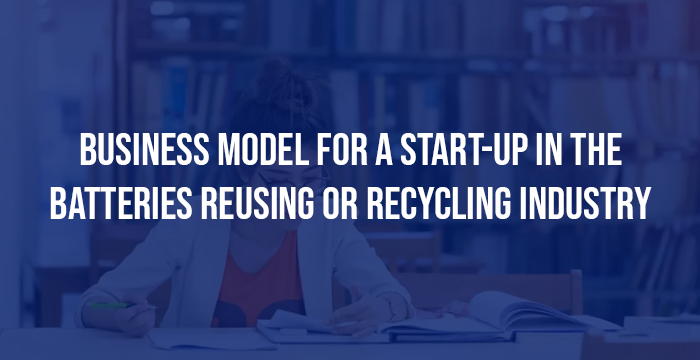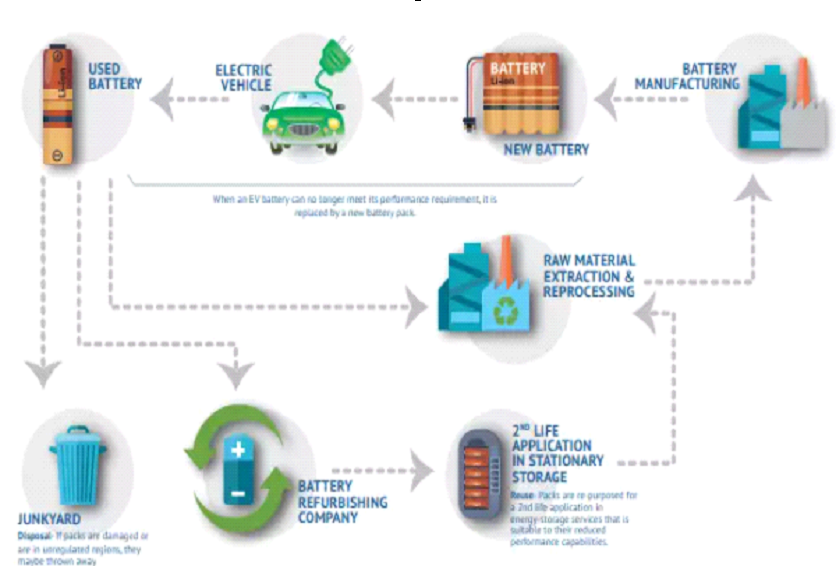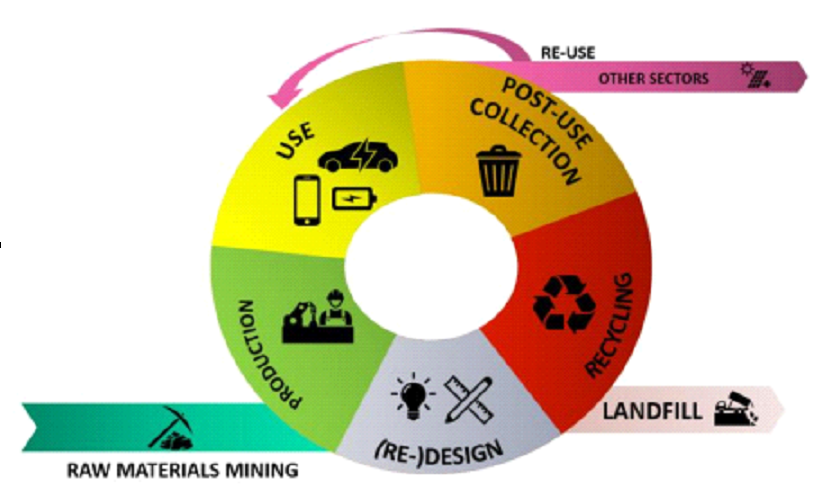
Executive Summary
This report has highlighted the opportunities a start-up “Recycling Vista” can implement to recycle used lithium-ion batteries. Lithium batteries pose a hazard to the environment due to improper disposal. This report has suggested an effective business model of Business to Business the start-up can implement, which would be helpful for the company to provide its products and value within the manufacturing market. Providing second life to batteries can create better options for electronic manufacturing and improves sustainability for the ecosystem. Therefore, this research has suggested using a Business to Business model for procuring used batteries and recycling them to give them a second life in other businesses and the value it would provide to clients using batteries in manufacturing.
Introduction
The rise in the use of batteries has become a cause of concern over the years because the disposal of lithium-ion batteries used in cars is a severe polluter to the environment. Disposal of car batteries is usually carried out by pyrometallurgy, which causes significant amounts of pollution for the environment. There is a growing need for alternative solutions that would allow for the reuse and recycling of lithium-ion car batteries for alternative use once its first life cycle gets over. Recycling Vista's start-up company intends to create a business model where the redistribution of used car batteries would improve the approach for recycling lithium-ion batteries across India. The mission statement for the company is to repurpose the used batteries and breathe a second life into them.
Issues being faced
The use of lithium-ion batteries was considered the solution to shift from the use of natural resources such as petrol and diesel for fuel in cars. However, the rise in the use of electric cars and lithium-ion batteries is raising issues of proper disposal after the end of its life. It is estimated that more than 12 million tons of lithium-ion batteries are expected to be out of use between 2022 and 2030 (Lim, 2021). This shows an increasing concern regarding the disposal of those batteries, and there is a need for recycling and repurposing of these batteries to reduce the reliance on mining for materials. It would also repurpose the use of the materials available to lessen the need for mining resources.
In countries like India, the rise in the use of electric cars has gradually caused the improper disposal and recycling of the Lithium-ion batteries used in electric vehicles. Currently, only about 5% of lithium-ion batteries are recycled globally, while it is unclear how they are handled (Woollacott, 2021). This gives concerning statistics of the rise in toxic pollutants in the environment from lithium batteries, which also creates an opportunity of repurposing and redistributing the method of recycling lithium-ion batteries for different uses.
Potential Solution
The potential solution for the rising concern for improper disposal of Lithium-ion batteries has given way to the opportunity of repurposing them through recycling. There are possible solutions for reusing and recycling Lithium-ion batteries to provide second life and a closed-loop recycling process. Batteries in electric vehicles experience a drop in capacity after it reaches 70-80% of its potential over the years (Priya, 2020). This increases the opportunities in refurbishing the batteries with a diminished capacity, which can be used to charge smaller load appliances in use. As Garoleet al. (2020) discussed, recovering valuable or spent materials or catalysts in the batteries repurposes recycled batteries into portable batteries for further use. This implies recycling the materials that make up a lithium-ion battery for portable batteries or reusing it leads to refurbishing it for future use in different appliances. This has led to the free redistribution of used catalysts for reusing the batteries with lowered potential.

(Source: Priya, 2020)
As seen in Figure 1, once the capacity of the batteries in electric vehicles reduces, they can be refurbished and given a second life for other appliances. Since car batteries require a high voltage to propel the car, refurbished batteries can be used for low voltage and wattage appliances.
Business Model for start-up
The start-up company would be based on a business model that takes a retired car battery and refurbishes and repurposes it for use in other electronic appliances, increasing the shelf life. This company would be based on a Business to Business (B2B) business model to make its way into the recycling battery industry. Paridaet al. (2019) mentioned that a significant potential for business innovation in business-to-business settings is that it provides revenue and value-producing opportunities. This implies that the company has figured out better ways for procuring used batteries of electric vehicles from businesses that take charge of retired and disposed-off cars. The company would then process the batteries and refurbish them to batteries suitable for appliances like mobiles and laptops along with electric scooters or even home appliances.
The B2B model for this start-up would be beneficial because it would create a channel for taking the discarded lithium-ion batteries from the dealers that would otherwise have used improper methods of disposal. The start-up can gather the items such as lithium-ion cells with cobalt, nickel, manganese and lithium and repurpose them. As per Einhorn et al. (2019), the tangible and intangible benefits have to be experienced by the stakeholders for the business to be successful. This implies that there needs to be a clear demarcation of the benefits that each stakeholder would attain in the business model for deriving success through the project. The B2B approach would help in procurement and dispersal of the refurbished batteries by approaching second-hand car dealers and garages that take used cars for disposal. The open-source, free distribution would be used to recycle and reassemble the battery cells' processes for repurposing.
Business Model Canvas
| Key Partners | Key Activities | Value Propositions | Customer Relationship | Customer segments |
|
|
|
|
|
| Key Resources | Channels | |||
|
| |||
Cost Structure
| Revenue Streams
| |||
Table 1: Business Model Canvas (Source: Influenced by Sparviero, 2019)
As is evident from Table 1, the business model follows the B2B approach in which it is in direct contact with other businesses to procure its materials and manufacturing companies that need lower voltage batteries. As per Sparviero (2019), identifying key elements within a business model and analysing their importance helps derive the usefulness of the elements, which means establishing a relationship with the partners and understanding the relationship present. Considering the Indian background, the company would have to engage with local car distributors and other manufacturers to procure the used batteries for electric vehicles.
It is also a priority for the company to influence customers to realise the usefulness of the refurbished products and make use of them in their products to increase sustainability in products. As per Ojasalo and Ojasalo (2018), sequential value creation processes within new businesses have to emphasise the customer's active role in value creation. It indicates that the awareness of the value of the refurbished products was beneficial and cost effective for their product manufacturing. Local companies must be contacted as customers since giving second life to batteries implies that the batteries would have a lower capacity than it was originally.
Value Proposition Canvas
| Value Proposition | Customer Segment |
Products & Services
| Customer Jobs
|
Pain Relievers
| Pains
|
Gain Creators
| Gains
|
Table 2: Value Proposition Canvas (Source: Influenced by Levänenet al. 2018)
It is evident from table 2 that the values that the recycled batteries provide to the start-up and its customers effectively create a circular economy in the sector. As Olsson et al. (2018) discussed, capturing the value left after the initial use of a product is one of the main foundations of the circular economy. This implies that the customers are more receptive to the products once they realise the value of the refurbished products. Hence, the value provided by the start-up would be suited well for the Indian market that provides a great opportunity in this field.
Potential benefits from the start-up model
The start-up model created has provided the opportunity to create a circular economy in electric vehicle battery recycling. Larger companies are looking into ways of refurbishing the used batteries for increased sustainability of their products. Companies like Tata and Mahindra have been looking into repurposing the batteries and recycling them (Priya, 2020). Although electric vehicles are eco-friendly, as they do not use fuel combustion, the battery's shelf life is relatively small. Gu et al. (2018) discussed that the end of life battery management that opened up possible options for reuse is an effective way to create better sustainability. This business model would benefit from the presence of batteries that would otherwise be incinerated, adding to the pollution.
The benefit of recycling batteries is that it reduces the filling up of landfills while also saving resources and providing second-life to different resources. As viewed by López Gómez et al. (2020), battery redesign, production, use, post-use collection and recycling reduces the prospects of mining raw materials and dumping on landfills. This implies that the start-up business has the potential to increase the effectiveness of the process. The company would also have a better possibility of collaborating with bigger companies present in the car manufacturing market and working with them. This would increase the value of the company and provide better funding for resources to attain sustainability. Similarly, as Hopkinson et al. (2020) mentioned, the shift from the "take, make, dispose of" paradigm present in every industry is in dire need of change. Hence, this company would be beneficial in shifting the present mindset of production and create a passage for better and sustainable measures in manufacturing.

(Source: López Gómez et al. 2020)
Potential challenges faced
There are potential challenges such as cost-effectiveness and less awareness present within the market of the business that is the recycling business, which indicates that there is a chance of slow growth. There are possible drawbacks that indicate that the company would struggle to make decent profits to survive in the market initially. As per Doose et al. (2021), there is a divergence in the high performance and cost-efficient batteries in the case of recycled batteries. This implies that there are possibilities that the market attractiveness of recycled products could be below. The company needs to increase the awareness among the businesses about the necessity of recycling and the benefits they would receive to increase the appeal of the company and its products. On the other hand, Beaudet et al. (2020) stated that recycling infrastructure has to ensure that the valuable but highly toxic materials present in Lithium-ion batteries are not wasted but reused to create sustainability for future generations. Therefore, the company has to ensure the materials are used accordingly to be repurposed and maintain a better possibility of sustainability.
Openness Chart
Open up
- Collection of retired and disposed of lithium-ion batteries
- Disassembling of the present batteries to strip the mechanism
Possible actions (for stakeholders)
- Increase awareness among other manufacturers
- Increase wait time for product orders made
- Chose raw materials or refurbished batteries for use
How to benefit
- Increased awareness would lead to improving clientele for the company
- There is also the possibility of wider outreach to gain procurement of used batteries
- Create product diversity in refurbished and recycled batteries along with raw materials
How stakeholders’ benefit
- Increased cost efficiency with a variety of products
- The profitable business relationship between the company and stakeholders
Channel for Exchange
- Lowered barriers to entry within the manufacturing supplier business
- Increased sustainability with recycled raw materials decrease mining and landfills
Value Extraction
- Cost benefits with procurements as businesses are ready to dispose of used batteries.
- Increase opportunities in royalty-free distribution increases opportunities for new businesses to grow
Recommendations for the startup
It can be recommended that the start-up Recycling Vista expand its business outside India after a few years. In this regard, this company can merge with the companies operating the same type of business. This company can make connections to develop this business communicating with foreign companies such as Toyota that manufacture electric cars. The start-up at first can contact large companies producing electric cars with subsidiaries in India. It has to be considered that this start up is taking the initiative in helping to reduce environmental pollution by recycling the wastage of recycling car batteries. The best way to improve its business operations is to merge with electric car manufacturing companies inside and outside India. The start-up can also take help from organisations researching electric cars to improve and recycle their batteries. In this regard, the start-up can get assistance from Ashok Leyland, the first electric bus producer in India (Ranjan, 2021). The company is working in relation to the improvement of their electric vehicle range. Therefore, the start-up can tie up with this previously mentioned company, which has a strong presence in other 50 countries worldwide.
In addition to the above-mentioned company, the start-up can communicate with the Exide Industry involved with storage batteries production in the automotive industry. Henceforth, the start-up can also follow the process of manufacturing batteries for electric cars.
My learning
The second lecture delivered by the professor has helped me understand the effective solar charger assembly process. In addition, the lecture has also helped me to understand how to write user-friendly documents as well. It has enhanced my writing skills also, which emerges to be very useful for my career. From this lecture session, I also have come to know how to publish open-source documents. The next sessions have assisted me in gaining knowledge about plastic moulding processes. In this regard, the concerning assignment has helped to understand how the batteries of electric cars can be recycled and refurbished once their initial life cycle is over. It helps to know all of the positive attributes of recycling electric batteries. It has helped to understand how the new business operations can enhance customer gains. Most importantly, this report has helped me acknowledge the significance of recycling and hope it helps reduce the chances of environmental pollution. It has also helped to understand the environmental value of electric cars and how the recycling of their batteries can be effective in the waste management system.
The final part of the research has helped me enhance my knowledge in the production of batteries because the concerned company is a start-up battery-making company that delivers its products to many electronics. Company investors and stakes could help maintain the deliverable of products that can achieve the target customers by explaining our criteria to satisfy customers by providing batteries with second life that can be used to power low-intensity appliances. The course facilitates my idea and knowledge that provides innovation in maintaining business improvements. I have learnt the ways to create a circular economy, use all resources for other uses, and minimise the waste generated.
Conclusion
This study focuses on the start-up company Recycling Vista, which is associated with India and decides to enter several countries for expansion. This company is a manufacturing company that offers repurposed and recycled batteries from other used cars and provide a second life to the batteries for usage in low power appliances and not the cars. Business model canvas and value proposition canvas has been used in this study to display the different beneficial attributes of the company. There are challenges with the nominal increased value of batteries as compared to single use batteries. However, increasing awareness about the environmental benefit and longevity of the batteries would help to manage the challenge and positively affect consumer retention. This implies that increasing awareness about this company's mission would help gain customers willing to bear nominally extra costs for sustainable batteries and raw materials used for making batteries.